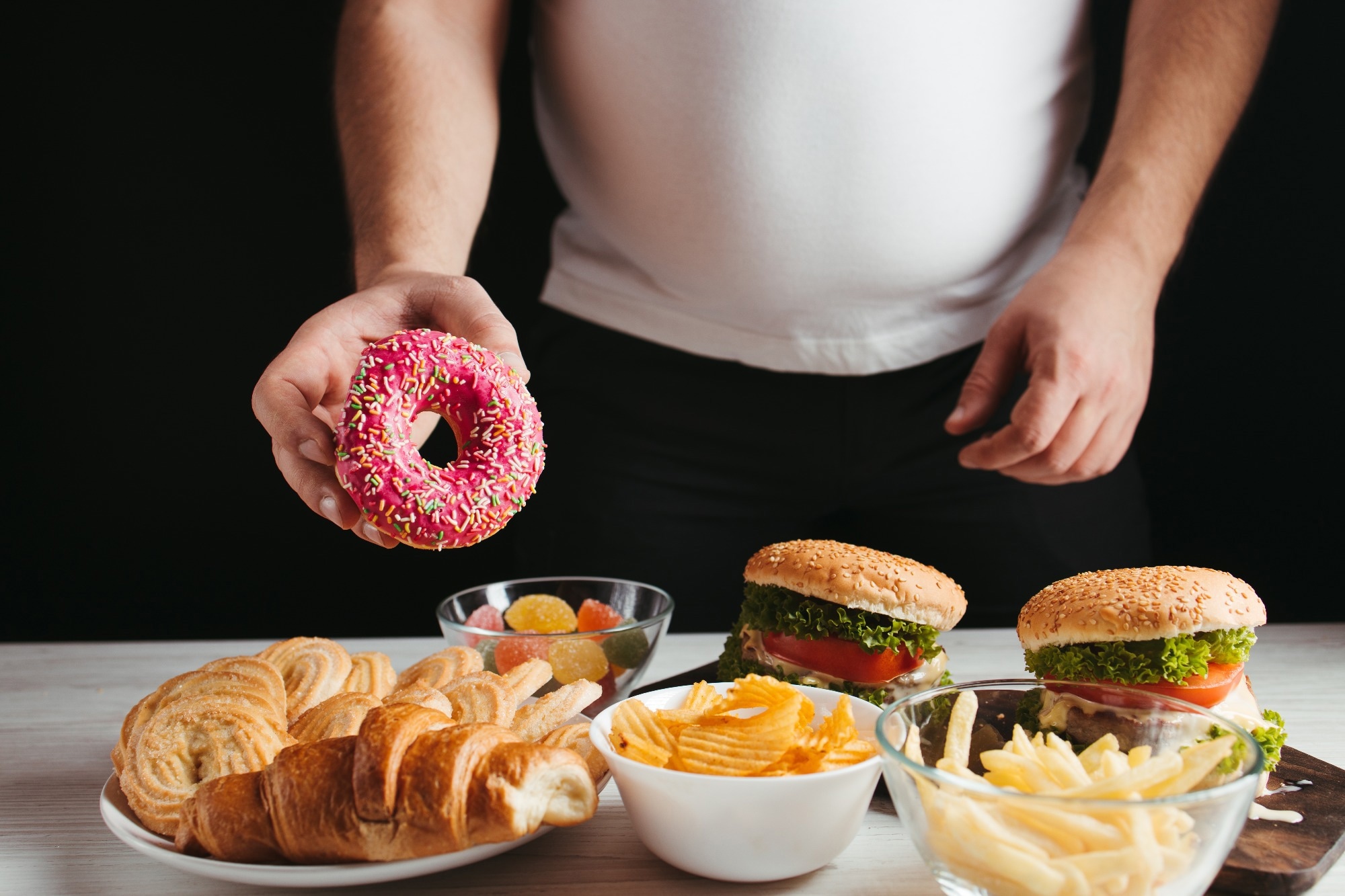In a recent study published in Cell Metabolism, researchers identify independent vagal sensing pathways for fat and sugar detection.
 Study: Separate gut-brain circuits for fat and sugar reinforcement combine to promote overeating. Image Credit: Flotsam / Shutterstock.com
Study: Separate gut-brain circuits for fat and sugar reinforcement combine to promote overeating. Image Credit: Flotsam / Shutterstock.com
How do sugar and fat affect digestive behaviors?
Changes in the food environment have significantly increased global obesity rates. Animal studies have revealed that palatability guides food choice; however, this factor alone is insufficient to increase intake.
Rather, flavor preferences form as a conditioned response to post-ingestive nutritive cues. Therefore, the orosensory characteristics of foods are secondary to their nutritional value.
The reinforcing value of intragastric sugar or fat infusions enhances the intake of associated flavors. Thus, consuming sugars and fats may lead to overeating through mechanisms involving post-ingestive signaling.
Vagal sensory neurons have been identified as crucial components of a multi-synaptic circuit linking the gut to nigrostriatal dopamine release. Gastrointestinal infusion of sugars or fats activates the vagus nerve and causes dorsal striatum (DS) dopamine efflux.
Study findings
In the present study, researchers evaluate whether sugars and fats recruit vagal sensory neurons and if they engage separate or overlapping circuits. To this end, in vivo imaging of nodose ganglia (NG) neurons in mice expressing a calcium indicator (GCaMP6s) under the synaptosome-associated protein 25 (Snap25) promoter was performed. Two-photon microscopy was used to record responses to the duodenal infusion of fat or sugar.
Spatially defined subsets of vagal neurons were activated in response to the stimuli. NG neurons mounted a strong response to fat or sugar; however, only a few neurons had a response to both.
Subsequently, vagal sensory neuron activity from the right NG was assessed following intragastric fat or sucrose infusion. NG neurons were active for over 15 minutes in response to fat or sucrose.
Notably, there were fewer nutrient-responsive neurons in the left NG as compared to the right NG. Intragastric infusion delayed the peak NG neuronal activity as compared to intraduodenal infusions.
Mice expressing an inducible Cre recombinase (iCreERT2) under a Fos promoter (FosTRAP) were crossed with Ai14, a Cre-dependent tdTomato reporter line. In these mice, most sugar-TRAP NG neurons increased calcium fluorescence in response to gastric sucrose infusions. By contrast, the sugar-TRAP neurons demonstrated little activity in response to the equicaloric gastric fat infusion.
TdTomato+ NG neurons increased after intragastric sugar infusion or equicaloric fat infusion as compared to isosmotic saline. Comparisons of neural activity suggested a dose-dependent response within the NG and nucleus tractus solitarius (NTS), thus indicating that sugars and fats recruit independent peripheral vagal circuits.
Thereafter, a flavor-nutrient conditioning task was performed, wherein animals were trained to prefer a novel flavor paired with intragastric nutrient infusions. Mildly fasted FosTRAP mice were stratified into groups to receive intragastric infusions of sugar, fat, or saline, followed by an intraperitoneal injection of 4-hydroxytamoxifen (4-OHT).
This procedure selectively ablated vagal sensory neurons based on their nutrient response profile, leaving other neurons intact. FatTRAP mice without fat-sensing NG neurons had a normal preference for flavor paired with sugar and failed to reinforce the flavor paired with fat.
SugarTRAP mice without sucrose-sensing NG neurons had selectively abolished sugar reinforcement. Comparatively, controls (salineTRAP) exhibited robust preferences for non-nutritive and novel flavors paired with fat or sugar.
These findings indicate that separate and mutually exclusive vagal sensory neuron populations independently drive fat or sugar reinforcement. Additional experiments revealed that separate circuits were necessary and sufficient for macronutrient-specific reinforcement.
In the duodenum, the innervation of mucosal endings in the intestinal villi was extensive in fatTRAP and sugarTRAP mice, thus indicating that the duodenum is a key sensing site. Vagal innervation of the hepatic portal vein (HPV) by sugarTRAP neurons was also observed.
The researchers also quantified 30-minute ad libitum intake in wild-type mice using a lickometer as animals licked solutions of sucrose, fat, or their mixture. Animals doubled the licks for the solution containing both fat and sucrose as compared to individual solutions alone.
The researchers also evaluated whether mice would exhibit the same consumption pattern if the nutritive aspects were isolated from the oral component. Food-restricted wild-type mice implanted with gastric catheters licked a flavored non-nutritive solution paired with infusions of fat, sugar, or their mixture.
Mice demonstrated an increased licking pattern for the mixture, thus suggesting that the elevated preference for the mix was taste-independent and due to post-ingestive signaling. Moreover, intragastric infusion of the mixture yielded a supra-additive number of TRAP neurons in DS, NTS, parabrachial nucleus, and substantia nigra pars compacta. Infusion of the mix also elevated dopamine levels.
Conclusions
The study findings imply the presence of separate circuits for sugars and fats. To this end, two distinct vagal sensory populations that independently respond to post-ingestive sugars and fats were identified.
Taken together, the data support the notion that higher caloric intake of Western diets results from hijacking interoceptive circuits, which separately reinforce sugars and fats.
The motivation to eat obesogenic foods may occur without cognitive perception, as interoceptive signaling occurs below the consciousness level, in which a conscious dieting effort is overpowered by the subconscious drive to eat fat- and sugar-rich foods. Thus, interoceptive gut-reward circuit manipulation could be targeted for treating obesity by voluntarily limiting the intake of obesogenic diets.
Journal reference:
- McDougle, M., de Araujo, A., Singh, A., et al. (2024). Separate gut-brain circuits for fat and sugar reinforcement combine to promote overeating. Cell Metabolism. doi:10.1016/j.cmet.2023.12.014